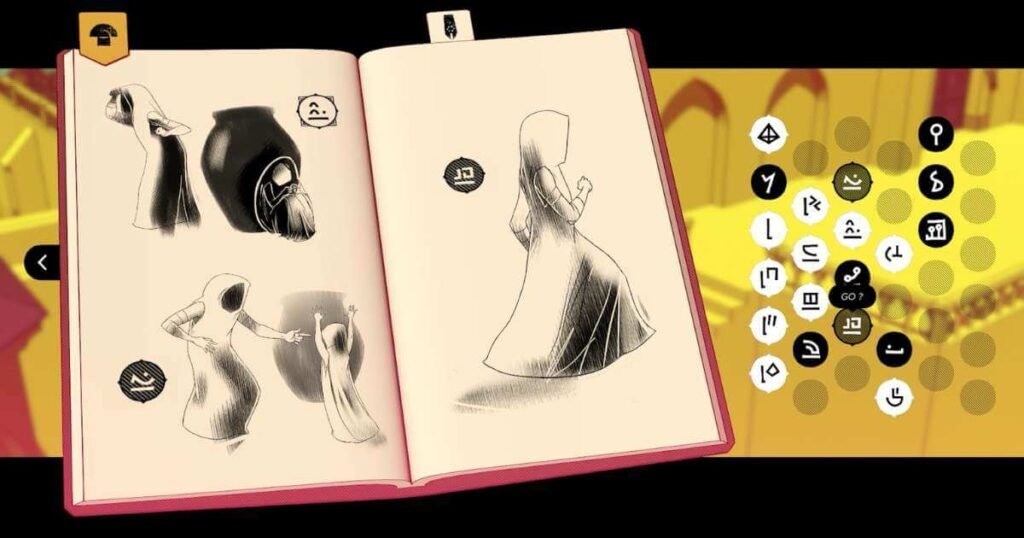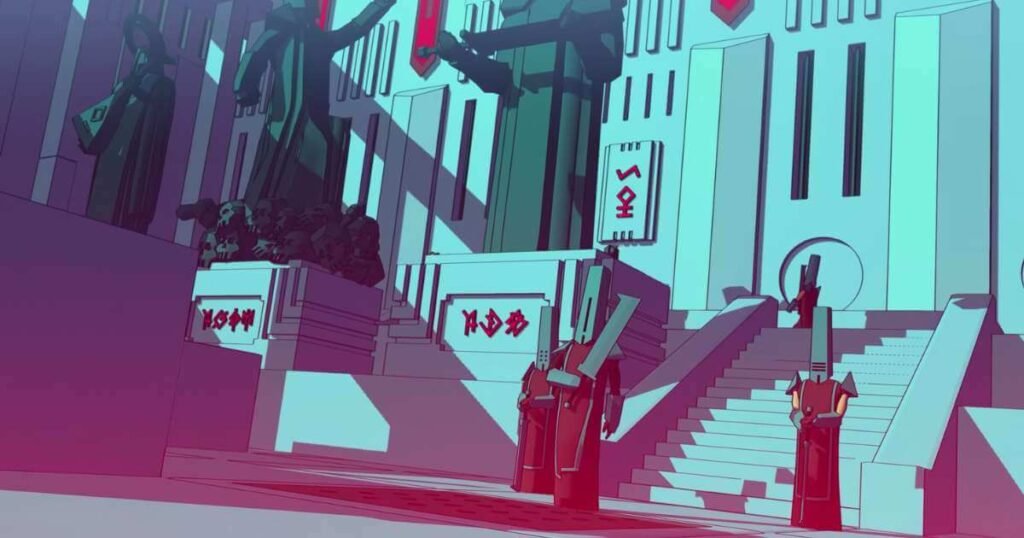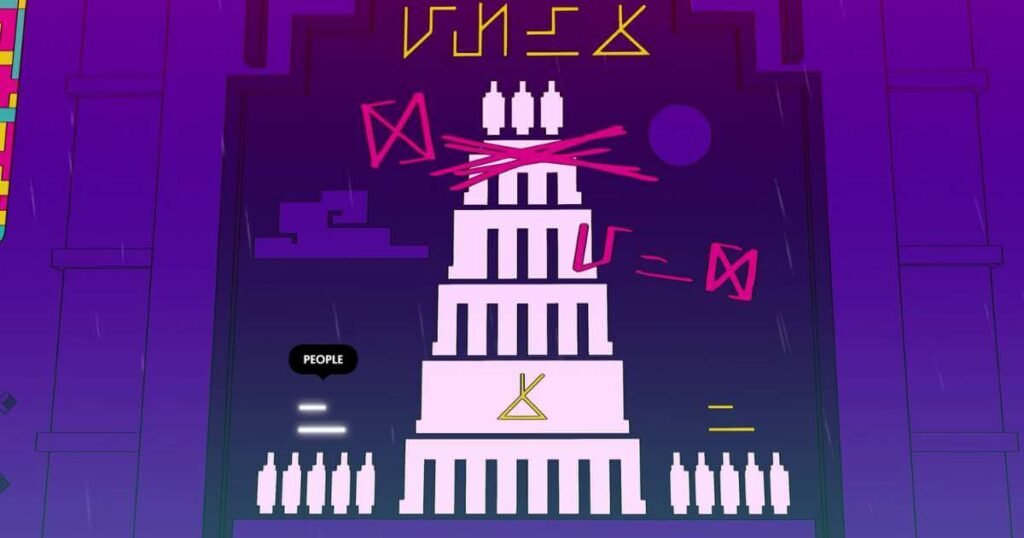A traveler is defined as “a person who is making a journey.” When framed in this literal sense, all gamers are travelers of sorts – they journey through the landscape of the games they play. Chants of Sennaar takes this idea a step further and puts players into the role of the Traveler.
The concept of a traveler is integral to Chants of Sennaar. Developers Rundisc said in an interview with Gamesindustry.biz, “From the moment the concept of languages came into the design, and then all along the rest of the development, we tried to reproduce the feeling of the traveler – the feeling you might have when you get off a train or a plane and find yourself in a country whose language you know nothing about.”
This scenario is familiar to anyone who has traveled. Upon disembarking at your destination, you are suddenly surrounded by unfamiliar sights, sounds, and customs – and that is part of the thrill (and stress) of traveling. The team at Rundisc tried to capture the “…feeling of gradually integrating into a culture through its language.”
The main gameplay loop in Chants of Sennaar requires players to decipher different languages as they move through the Tower. Each floor in the Tower has its own language, which the Traveler must learn in order to progress. The game is light on tutorials, giving players just enough information to get started. Rather than being a drawback, this adds to the overall experience of being a traveler, mimicking the first few hours (or days) of being in a new country and trying to figure out how day-to-day life works.

The Traveler records new glyphs in their journal, and players must correctly match the glyphs with the illustrations to unlock the meaning.
When Rundisc was developing Chants of Sennaar, they took inspiration from existing languages for the form of the in-game languages. Despite this real-world influence, the structure of each language was created to support gameplay elements.
“We were looking to create fantasy languages designed for the needs of the game. There was no scientific intent. The languages in Chants of Sennaar are puzzle elements like any others. They were created as part of a game design process, not a linguistic one.”
While Chants of Sennaar is a game about languages, it is not a linguistic game. Players learn the meaning of different symbols as they progress, but the game automatically “translates” this into a logical sentence. No worrying about subject/verb agreement or tense shifts here!
“We were looking to create fantasy languages designed for the needs of the game. There was no scientific intent. The languages in Chants of Sennaar are puzzle elements like any others. They were created as part of a game design process, not a linguistic one.”
Julien Moya, Rundisc
Even though the simplicity of the languages was a design decision, it adds to the feeling of being a traveler trying to learn a new language. Usually, travelers pick up words here and there through context and repetition, much like the game. Then, they’ll try to incorporate what they learned into basic sentences without worrying about the grammatical structure – it’s about getting the point across.
There are five languages in Chants of Sennaar, and they become more complicated as players move to higher levels in the Tower. Each language uses a logographic writing system, in which a symbol represents an entire word. Every floor in the Tower has a unique writing system, along with specific grammar rules for the language.
Below is a breakdown of each language in the Tower. We recommend skipping |
First Floor
The first floor of the Tower is home to the Devotees. The developers loosely based this level on ancient Mediterranean culture, drawing inspiration for the language from the Latin, Phoenician, and cuneiform alphabets. The Devotees’ language has 34 glyphs and uses a subject-verb-object grammar structure with glyph-based repetition to indicate plurals.

Second Floor
The second floor of the Tower is home to the Warriors. Players will first encounter the Warriors during the Devotee section and receive several glyphs, but will only be able to decipher them once progressing to the second floor. The Warriors’ language has 36 glyphs and uses a subject-verb-object grammar structure. This language introduces a specific glyph for plurals and does not use personal pronouns.

Third Floor
The third floor of the Tower is home to the Bards. Players will notice that the Bards’ language is extremely different in form from the previous two languages due to inspiration from Arabic Kuffic and Indian Devanagari. The Bards’ language has 42 glyphs and uses an object-subject-verb grammar structure. This language also introduces a specific glyph for questions.

Fourth Floor
The fourth floor of the Tower is home to the Alchemists. Because of their interest in experiments and formulas, this is the first language to introduce numbers. The Alchemists’ language has 41 glyphs in total, with individual glyphs for the numbers 0 through 9. This language uses a subject-verb-object grammar structure.

Fifth Floor
The fifth and final floor of the Tower is home to the Anchorites. The process of learning this language is different than the other four floors and relies on the Traveler’s knowledge gathered throughout their journey through the Tower. The Anchorites’ language has 32 glyphs and uses a subject-verb-object grammar structure. It is the only language without a glyph for the word “warrior.”

After completing the Anchorites’ language, the Traveller is tasked with acting as a translator and reestablishing connections between the peoples of the Tower. Much like the polyglot friend in a traveling group, players will facilitate communication between the Devotees, Warriors, Bards, and Alchemists using the glyphs learned throughout the course of the game.
Chants of Sennaar delivers on Rundisc’s goal of trying “to reproduce the feeling of a traveler.” From the languages to the gameplay mechanics, everything in the game supports this concept. Even the difficulty of the puzzles supports the experience, with the developers tweaking them to provide “just the right amount of frustration.”
Undoubtedly, there are certain sections of Chants of Sennaar that can be frustrating. Arriving in a new place and not speaking the language is always a challenging task. However, once you overcome the initial roadblocks, it becomes rewarding. And if communication is proving a little too difficult (either in Chants of Senaar or during real-life travel), there’s always Google to help you out. Happy gaming!













Add comment